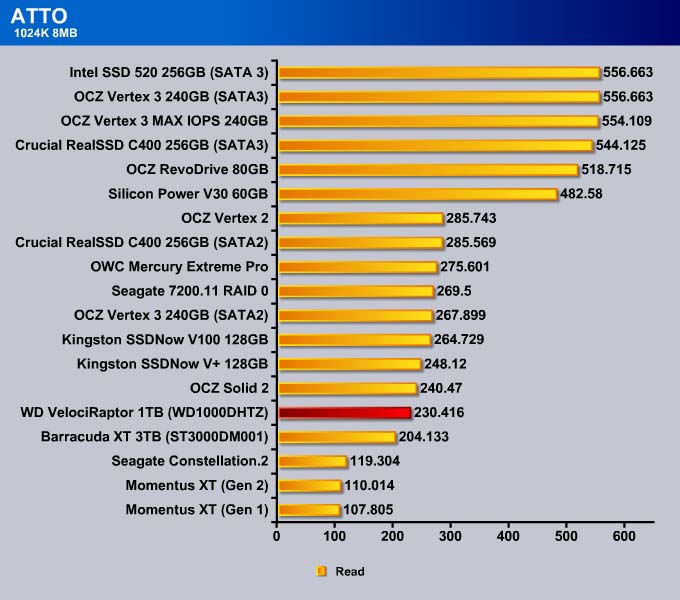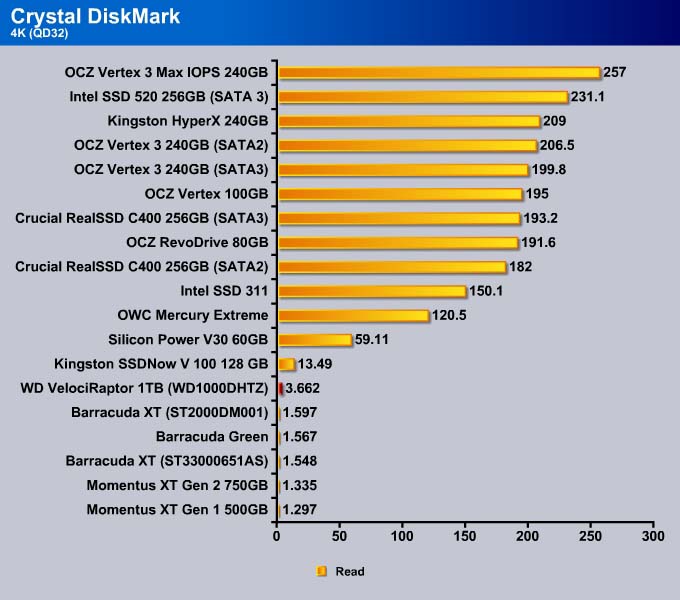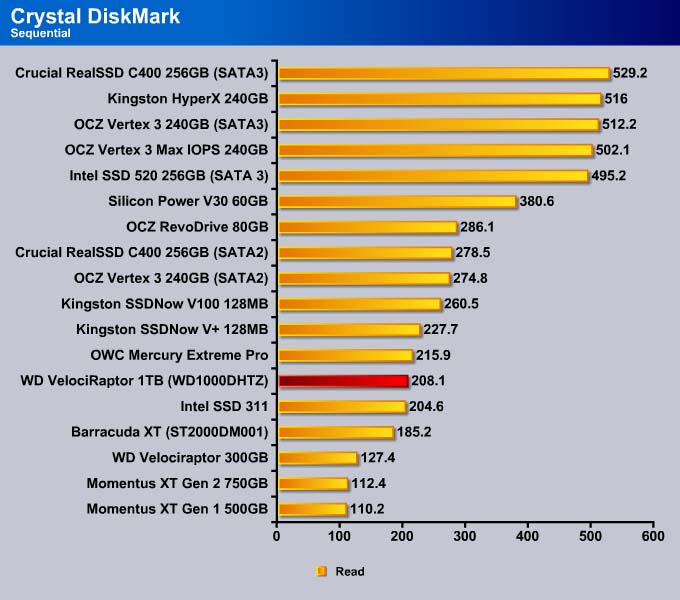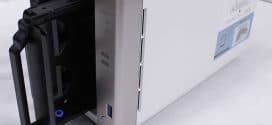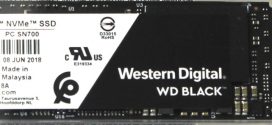The WD VelociRaptor 1TB hard drive comes with a 10,000 RPM spindle speed and a whopping 333GB per platter! How does it stack up against a growing slate of SSD’s and hybrid hard drives? Keep reading to find out.
introduction
Ten years ago, the Western Digital Raptor wowed users with its 10K RPM drive which brought significant performance improvement on the storage. It quickly won over many PC enthusiasts and gamers due to much better performance as a result of its faster spindle speed compared to standard desktop storage solutions. Mechanical drives can increase performance by either spinning at a faster speed or increase areal density. By combining both options, the Raptor is able to deliver performance gain over other drives, even if they have high areal density.
Over the last few years, the landscape of storage for performance PC’s has changed dramatically as SSDs have burst onto the scene, becoming the de facto choice of drive for enthusiasts. The SSD’s superior random read and write performance significantly improves a system’s overall performance as applications launch faster and data retrieval at almost instantaneously rate. Despite its performance, SSDs are still relatively expensive and the price-to-storage capacity ratio is much higher compared to that of mechanical drive. A 240GB SSD costs at $300 whereas the same price can buy a 3TB hard drive.
Although SSD prices have been dropping steadily over the last couple of years, we do not expect to see match the same price per GB that hard drives have. Thus, not everyone can afford an SSD. Until SSDs reach the point that the storage capacity is large enough and the pricing is affordable enough, hard drives will remain a primary form of storage. At the moment, the market for the mechanical drives is not dead and even for those who have an SSD as the primary drive, mechanical drives continue to serve as storage or backup drives.
The new Western Digital VelociRaptor launched recently is aimed to deliver the performance to those who are still using mechanical drives. We have received the drive from the company, and we’re going to see if it is worth its $319 price tag.
Western Digital VelociRaptor (WD1000DHTZ)
Western Digital launched three new VelociRaptor drives with capacities of 250GB, 500GB, and 1TB. Compared to common desktop storage with maximum capacity of 3TB drives, the VelociRaptor is still relatively small in terms of capacity but 1 TB of space is ample for most people. This is a 400 GB bump from the the previous generation drive.
| Model | WD1000DHTZ | WD5000HHTZ | WD2500HHTZ |
| Form Factor | 3.5 inch | 3.5 inch | 3.5 inch |
| Capacity | 1 TB | 500 GB | 250 GB |
| Interface | SATA 6Gbps | SATA 6Gbps | SATA 6Gbps |
| Rotational Speed (RPM) | 10,000 | 10,000 | 10,000 |
| Buffer Size (MB) | 64 | 64 | 64 |
| Platter Density (GB) | 333 | 333 | 333 |
| Number of Platters | 3 | 2 | 1 |
| Price (USD) | 319 | 209 | 159 |
This will be the first VelociRaptor that offers Advanced 4K sector format. The drive has an areal density of up to 333 GB/platter. Three platters are used to achieve the 1 TB storage space. The drive is still 2.5’’ but housed in a 3.5’’ IcePack adapter that acts as a giant heatsink to help dissipate the heat from the fast moving platters. The cache has been bumped to 64 MB from the 32 MB found on the last iteration.
Despite the fact the VelociRaptor is physically a 2.5” form factor, it will not fit into a laptop as it is 15mm thick. Even if your notebook could accommodate the drive we don’t recommend installing it as the heat output will be too much for a notebook to handle. The drive can be removed from its IcePack adapter if you unscrew the four Torx screws on the bottom, which incidentally will void the warranty.
In terms of the pricing, the 1 TB VelociRaptor is selling at $319, which is just under twice of the price of a regular 3 TB desktop drive. The 500 GB VelociRaptor is $209, and the 250 GB is $159. In terms of capacity and cost, the 1TB VelociRaptor is about $0.32/GB, compared to $0.06/GB for a regular 3 TB drive. This is still very affordable compared to SSDs, which run at around $1.25/GB of storage.
While may not necessarily designed for the same market, the Seagate Momentus XT is the drive that many people would probably be thinking which to one to buy when shopping for a new drive. The highest capacity Momentus XT retails at $154.99 on Newegg with 750GB of space. This works out to be $0.21/GB. Thus, the Momentus XT certainly has its appeal with its onboard NAND and lower price ratio.
The VelociRaptor features NoTouch ramp load technology where the recording head never touches the disk media to ensure less wear and better drive protection in transit. The Rotary Acceleration feed forward optimizes operation and performance when drives are used in vibration prone, multi-drive chassis.
Western Digital markets the drive for the high-end video and photo editing, low-end server, and performance enthusiasts’ systems. Western Digital also provides a 5 year warranty on the drive; this is a welcome sight, as we have seen lately that hard drive and SSD manufacturers alike have reduced their warranties to 3 years.
TESTING & METHODOLOGY
To test the Seagate Momentus XT 750GB, we cloned our test rig drive to the drives. It is the same test drive we’ve been using on all of our drive testing and is nothing more than a clean Windows load with all the drive testing software installed, as well as all the current drivers and patches for the OS. It’s the equivalent of doing a fresh load of Windows 7 from the disc but takes a lot less time and ensures that every drive tested uses exactly the same OS load and drivers. Nothing that may effect the outcome of the testing procedure can creep in. We ran all of the tests a total of 3 times and averaged those results. The Average of the three results are presented here. In the case of a pictorial benchmark we ran the bench 3 times and picked the median result. As with most SSD testing differences from run to run are minimal and the median result is a good indication of what you can expect from the drive.
We ran our usual battery of tests on the drive, and used it as the primary boot drive during testing. All of the drives tested were used as the primary boot drive during testing. That’s a more realistic test than strapping the drive in and testing it with a bare format or as a non-boot drive and it represents real life transfer rates, much like you can expect when you install and operate the drive in your own system. Each test was performed 3 times and the average of the 3 test run is reported here.
Test Setup
| Test Setup | |
| Case Type | None |
| CPU | Intel Core i5-2500K |
| Motherboard | Asus P8Z68-V Pro |
| RAM | Kingston HyperX 1600MHz |
| CPU Cooler | Prolimatech Megahalem |
| Storage Drives | Seagate Momentus XT 750GB Seagate Barracuda XT 3TB Seagate Momentus XT 500GB OCZ Vertex 3 MAX IOPS 240GB Silicon Power Velox V30 60GB OCZ Vertex 3 240GB OCZ RevoDrive 80GB OCZ Solid 2 60GB Kingston SSDNow V+ 128GB MLC WD VelociRaptor’s 300GB |
| Optical | None |
| GPU | Gigabyte GTX 580 SOC |
| Case Fans | 120mm Fan cooling the mosfet CPU area |
| Docking Stations | None |
| Testing PSU | Cooler Master UCP 900W |
| Legacy | None |
| Mouse | Microsoft Intellimouse |
| Keyboard | Logitech Keyboard |
| Gaming Ear Buds | None |
| Speakers | None |
Test Suite
| Benchmarks |
| ATTO |
| CrystalDiskMark |
| AS SSD Benchmark |
| PCMark 07 |
ATTO
We start with ATTO as it is the standard tool used for measuring a mechanical drive’s performance.
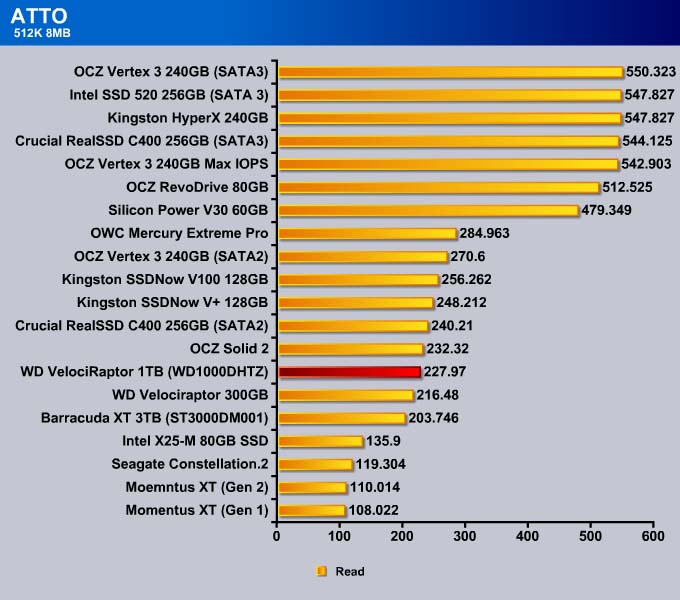

There is no question that the VelociRaptor is the fastest mechanical drive available today. Compared to the previous generation drives, we see about 5% improvement. The VelociRaptor is about 12% faster than the Seagate Barracuda XT 3TB. Adding the Seagate Momentus XT into the mix, we can see that the VelociRaptor is twice as fast as the Momentus XT.
HD Tach
Thanks to the faster spindle speed and higher areal density, the VelociRaptor’s burst speed is rather quite good at 353 MB/s. The Barracuda 3TB drive has a higher density than the VelociRaptor due to its 1TB platter density.
The average read for the VelociRaptor is 170 MB/s, almost as fast as two of the previous generation drive in RAID 0 configuration.
The average write speed of the drive is 169.5 MB/s, much faster than the Momentus XT and equals that of the Barracuda 3TB.
Looking at HD Tach, we can see that the VelociRaptor’s read and write performance is about even across the drive. The drive starts off with 220MB/s when reading and writing data near the edge of the platter. As approaches the center of the platter, it still maintains approximately 120MB/s transfer rate.
The random access time of 7.3 ms is the fastest we have seen on any hard drive thanks to the VelociRaptor’s 10K RPM. While it is not up to the level of SSDs, it is about half what we are used to seeing on a spinning platter drive. Additionally, the CPU usage for the drive is relatively low at 2%.
CrystalDisKMark
CrystalDiskMark is designed to test SSDs. It will give us an idea on the performance difference using an SSD vs hard drive. We purposely selected an old SSD like the OCZ Solid 2 for comparison.
4K
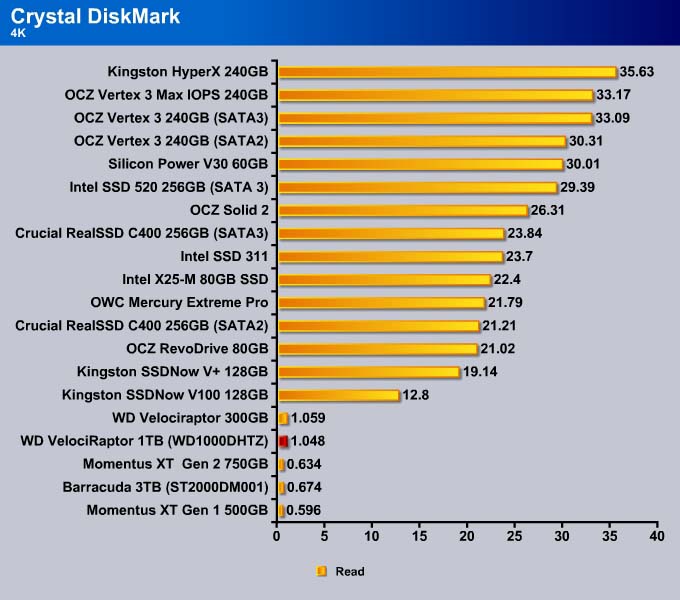

Thanks to the faster spindle time, the random read and write for the VelociRaptor is 2-3x faster than the Seagate Barracuda 3TB. Since the CrystalDiskMark is designed read and write random data, it will not showcase the Momentus XT’s performance. Thus, the Momentus XT is slower than the VelociRaptor here.
We can see that even the old drive like the OCZ Solid 2 is at least twice as fast in the random write. Even a relatively slow SSD like the Kingston SSDNow V100 is at least 10x faster in the random read than the VelociRaptor.
The VelociRaptor scales quite well at higher queue depths compare to the other mechanical drives.
512K
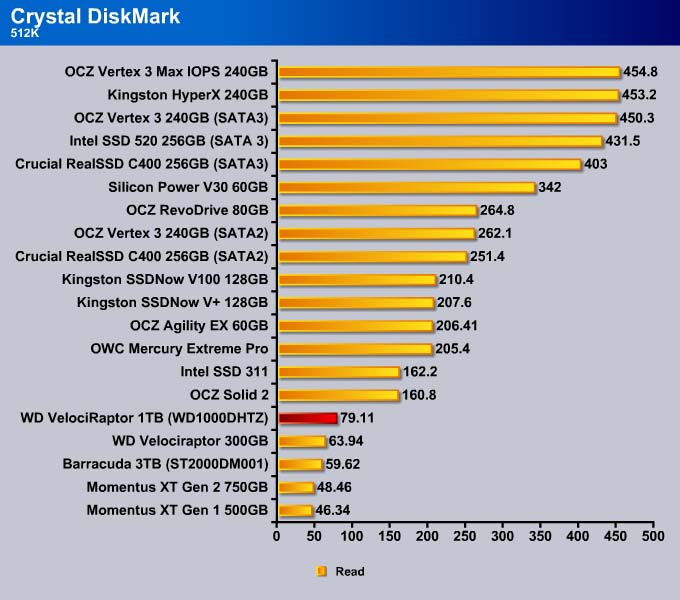

The 512K write performance for the new drive is about twice as fast as the older drive. Here we can see that the VelociRaptor also beats out a couple of older SSDs.
Sequential

The sequential read performance of the VelociRaptor is also about 10% faster than the Barracuda.
PC MARK 07
While PCMark 07 is a synthetic test, it is nonetheless a tool that allows us to measure the drive’s caching performance. We already know that new drive’s physical platter performance is similar to the first gen drive, we are wondering if the double of the NAND on the second generation and the improvement of the NAND read and write speed would have any impact.
Here we ran PCMark 07’s HD Suite test for a total of 5 times to see the performance of the drive with and without data caching.
The Overall score of PCMark 7 gives us an idea how the VelociRaptor can compete against other drives. This is a test where the the onboard NAND on the Seagate Momentus really shines. We can see that the VelociRaptor is about 20% faster than the fastest hard drive. However, any SSD caching drive like the Seagate Momentus XT or even the Intel Rapid Response is faster than even the fastest hard drive.
Looking at the chart above, we can see that the VelociRaptor is 20% faster than the Barracuda XT. However, it lags behind the Seagate Momentus XT, which is 12% faster. The Momentus XT caches frequently used files to its onboard NAND for quicker application launching. After running the same application about four or five times on the Momentus XT, it is about 39% faster than the VelociRaptor.
At best the VelociRaptor will perform similar to the Momentus XT but once the Momentus has finished caching the data, it shows a greater performance enhancement.
Video Editing and Media Center tests focus on a drive’s ability at handling sequential data. Since the Momentus XT selectively avoids caching large file, the onboard NAND has no benefit here. As a result, the VelociRaptor is faster here. Certainly, the VelociRaptor will be a good storage drive but as a primary drive, it is not the best choice.
The fast application loading time is really why SSDs are the choice for enthusiats. We can see that compare to any hard drives, SSDs will load applications at least 10 times faster. Even an old SSD like the OCZ Solid 2 is at least 5 times faster.
While the VelociRaptor is much better than the Barracuda, the Seagate Momentus XT has a clear advantage here with three times the performance. The performance difference between the VelociRaptor and the Barracuda is probably not noticeable, but the difference between the VelociRaptor and the Momentus XT definitely would be.
Conclusion
It is interesting to see Western Digital give the VelociRaptor another boost and release the new drive given the fact that the enthusiasts storage has shifted toward SSD. There is no question that the VelociRaptor is the fastest desktop hard drive available. Compared to other hard drives, we can see that the VelociRaptor is 20-30% faster. Its fast seek speed and high sequential read and write throughput surely will put any platter drive to shame. Unfortunately for Western Digital, SSDs are about at least twice as fast and newer drives can be ten times faster. The VelociRaptor is simply dwarfed by the SSDs or any hybrid solution (SSD+HDD).
The problem with the VelociRaptor is not its quality or performance, but its rather its pricing. At $300, the drive carries a significant premium and a very high dollar per GB ratio compared to a drive like the Seagate Momentus XT. While the Momentus XT’s sequential read and write is much slower than the VelociRaptor, its random read and write is significantly faster due to the onboard NAND data caching which will make applications launch faster and system feels faster. Retailing at $160, the 750GB Momentus XT is also cheaper than not only the 1 TB but also the 500 GB VelociRaptor. It would make better sense in terms of price-to-capacity and performance to choose the Momentus XT over the VelociRaptor.
The new VelociRaptor certainly has its appeal with its high sequential read and write performance over any hard drive. Thus, it will give you slight advantage even if it is used in a hybrid solution (SSD+HDD). However, its high price makes it hard to swallow. If a user is seeking a relatively small SSD for primary OS and applications, it is unlikely that they would be willing to spend $300 for a secondary drive as storage. Of course, users can always opt for a lower-capacity VelociRaptor but then for the same price, it probably would make more sense to choose a larger capacity drive like the Barracuda 3 TB.
To make the VelociRaptor competitive, it needs to be cheaper. Despite growing trends favouring SSD’s, mechanical drives will still remain drives of choice for storage and backup. Going forward, Western Digital probably needs to start putting some NAND on the drive much like the Seagate Momentus XT. This would give us the best of both worlds: the NAND would act as a cache for fast random read and write and the faster spindle speed would offer us a great sequential read and write.
While the VelociRaptor has lost its appeal to the SSD for the enthusiasts, it still has a good use in the workstation, server environment. SSDs are simply too expensive for these markets, where large amount of data are being stored. We are sure that the VelociRaptor will do well on those market and with its proven technology and 5-year warranty, the drive is definitely going to be a great choice for its performance and reliability.
| OUR VERDICT: Western Digital VelociRaptor 1TB | ||||||||||||||||||
|
||||||||||||||||||
| Summary: Western Digital has taken the desktop hard drive to the next level with the 1TB VelociRaptor. Armed with 10,000 RPM spindle speed and a higher areal density, this is the fastest hard drive we have tested. Despite its high price, for its performance it earns the Bjorn3D Bronze Bear Award. |
 Bjorn3D.com Bjorn3d.com – Satisfying Your Daily Tech Cravings Since 1996
Bjorn3D.com Bjorn3d.com – Satisfying Your Daily Tech Cravings Since 1996



